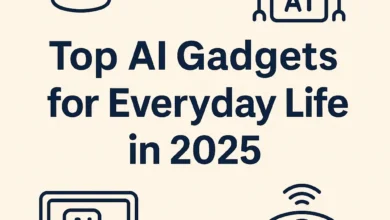
How 6G-Powered Edge Computing Will Transform AI and IoT
Introduction
The evolution of wireless connectivity has always played a crucial role in shaping the future of technology. With 6G on the horizon, it promises groundbreaking advancements that will redefine AI and IoT. The upcoming generation of wireless technology is expected to deliver ultra-low latency AI, seamless IoT connectivity, and 6G-powered edge computing. But how exactly will 6G reshape the way AI and IoT function in smart cities, industries, and daily life? This article delves into the transformative impact of 6G on AI-driven automation, autonomous systems, and smart city infrastructure.
Understanding 6G: The Next Leap in Connectivity
Before exploring its impact, let’s understand what sets 6G apart. While 5G brought incredible speed and lower latency, 6G aims to take it a step further by offering:
- Speeds up to 100 times faster than 5G
- Near-zero latency (sub-millisecond delays)
- Enhanced AI integration
- Greater energy efficiency
- Massive IoT support
According to tech experts, “6G will not just be about faster speeds; it will be about intelligent connectivity, Smart city automation, and real-time responsiveness.” These improvements mean that AI can make real-time decisions, IoT devices can communicate instantly, and futuristic applications like autonomous systems and smart cities can function seamlessly.
Ultra-Low Latency AI: Enabling Real-Time Decisions
One of the most significant breakthroughs of 6G is its ultra-low latency, which allows AI to process and execute decisions in real-time. In industries like healthcare, transportation, and finance, this will be a game-changer.
For instance, in Smart city automation vehicles, AI-powered systems will be able to analyze road conditions, detect obstacles, and respond instantaneously without delays. Similarly, in healthcare, AI can assist in remote surgeries, where robotic systems require zero-lag connectivity to perform delicate procedures with high precision.
As one industry leader puts it,
With 6G-powered AI, the concept of instant decision-making will no longer be a futuristic dream but a present-day reality.
Seamless IoT Connectivity: A Fully Integrated Network
IoT is rapidly expanding, connecting everything from smart homes to industrial automation. However, current networks often face latency issues and bandwidth limitations. 6G-powered IoT aims to eliminate these barriers by offering:
- Massive device connectivity (up to 10 million devices per square kilometer)
- Faster data transmission for instant communication
- Energy-efficient operations for longer battery life
Imagine a world where smart homes, security systems, and wearable devices interact instantly and intelligently. With seamless IoT connectivity, devices will operate in a synchronized manner, improving efficiency and convenience.
6G will empower IoT like never before, creating a truly interconnected ecosystem where everything communicates in real-time,
says a leading telecom analyst.
AI-Driven understanding 6g Automation in Smart Cities
Smart cities rely on AI to manage traffic, energy consumption, and public services efficiently. 6G will empower AI-driven automation in smart cities by providing:
- Predictive analytics for traffic control
- Efficient waste management through sensor-based AI systems
- Optimized energy consumption with smart grids
For example, traffic lights powered by AI and 6G will be able to analyze real-time congestion data and adjust signal timings dynamically, reducing traffic jams. Similarly, AI-integrated surveillance systems will ensure better urban safety and security.
Smart cities will no longer be a vision of the future; they will be the new normal with 6G-driven AI automation ensuring smooth operations and efficiency.
6G-Powered Edge Computing: Revolutionizing Data Processing
Currently, cloud computing plays a vital role in AI and IoT applications, but it often introduces latency due to data transmission delays. 6G-powered edge computing will solve this by bringing computation closer to the source, ensuring:
- Faster data processing at the network edge
- Reduced dependency on centralized cloud servers
- Increased security and privacy
For industries such as manufacturing and autonomous robotics, this will mean instant machine-to-machine communication, leading to better productivity and minimal downtime.
A tech executive notes,
Edge computing combined with 6G will revolutionize real-time data processing, making industries more efficient and reducing reliance on traditional cloud systems.
Enhanced Autonomous Systems and Robotics
Autonomous systems, including self-driving cars, drones, and industrial robots, will significantly benefit from 6G’s capabilities. With ultra-fast speeds and zero-latency AI, these systems can function more efficiently, leading to:
- Safer autonomous driving with instant AI responses
- High-precision robotic automation in industries
- AI-powered drones for logistics and surveillance
For instance, in the logistics sector, AI-driven drones can optimize delivery routes in real time, reducing delays and operational costs.
Autonomous systems will no longer be limited by network constraints; 6G will unlock their full potential, making them more responsive and efficient,
says a robotics engineer.
Challenges and Future Prospects
While 6G holds immense potential, there are some challenges that need to be addressed:
- High infrastructure costs for deployment
- Complex security risks due to increased AI-IoT integration
- Standardization issues across different countries
However, with continuous research and collaboration among tech giants, these challenges will likely be overcome, making 6G the backbone of future AI and IoT ecosystems.
Conclusion
The arrival of 6G technology will be a defining moment in the evolution of AI and IoT. With its ultra-low latency, seamless IoT connectivity, and 6G-powered edge computing, the world will witness smarter automation, efficient smart cities, and advanced autonomous systems. As research and development progress, the full potential of 6G will unfold, paving the way for an intelligent, interconnected future.
As a leading telecom researcher states,
6G will not just connect devices—it will empower intelligence, enabling a truly futuristic digital world.




